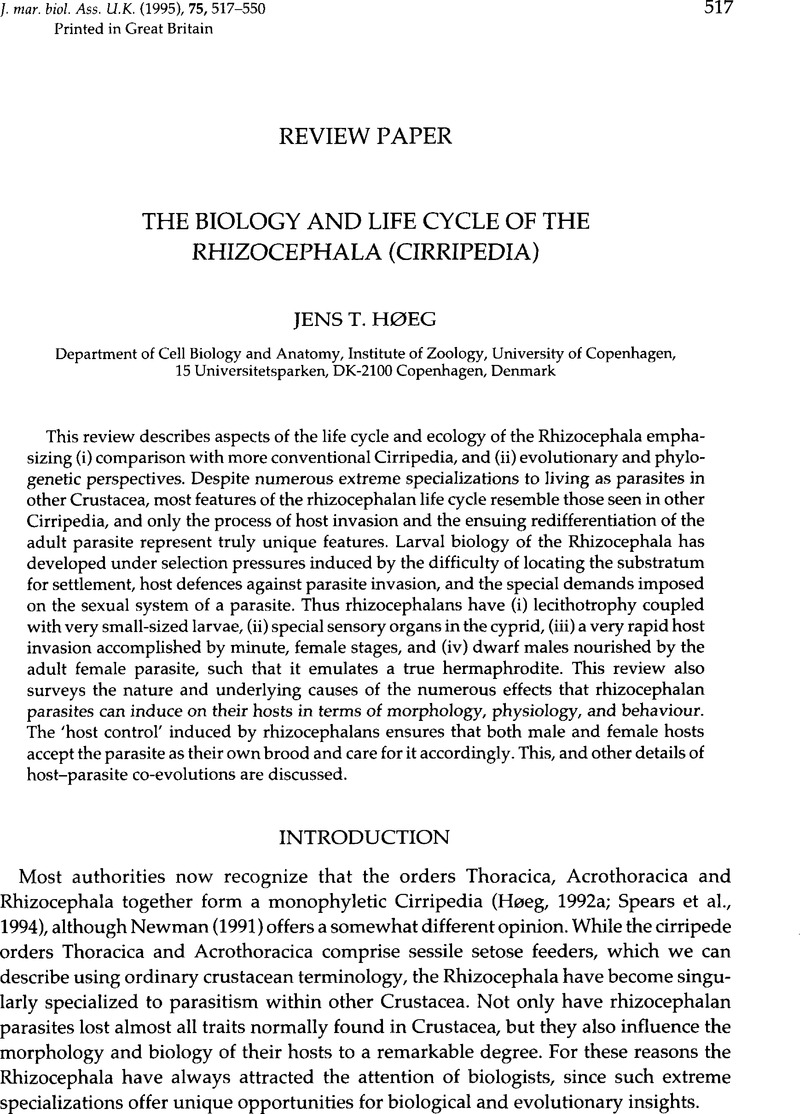Crossref Citations
This article has been cited by the following publications. This list is generated based on data provided by Crossref.
Poulin, Robert
and
Hamilton, William J.
1997.
Ecological correlates of body size and egg size in parasitic Ascothoracida and Rhizocephala (Crustacea).
Acta Oecologica,
Vol. 18,
Issue. 6,
p.
621.
Craig, Sean F.
Slobodkin, Lawrence B.
Wray, Gregory A.
and
Biermann, Christiane H.
1997.
The ‘paradox’ of polyembryony: A review of the cases and a hypothesis for its evolution.
Evolutionary Ecology,
Vol. 11,
Issue. 2,
p.
127.
Innocenti, G.
Vannini, M.
and
Galil, B.S.
1998.
Notes on the behaviour of the portunid crabCharybdis longicollisLeene parasitized by the rhizocephalanHeterosaccus dollfusiBoschma.
Journal of Natural History,
Vol. 32,
Issue. 10-11,
p.
1577.
Mouchel-Vielh, Emmanuèle
Rigolot, Catherine
Gibert, Jean-Michel
and
Deutsch, Jean S
1998.
Molecules and the Body Plan: TheHoxGenes of Cirripedes (Crustacea).
Molecular Phylogenetics and Evolution,
Vol. 9,
Issue. 3,
p.
382.
Walker, Graham
1999.
The cypris larvae of the rhizocephalan barnacle Heterosaccus lunatus with particular reference to antennular morphology.
Acta Zoologica,
Vol. 80,
Issue. 3,
p.
209.
Poulin, R.
and
Thomas, F.
1999.
Phenotypic Variability Induced by Parasites:.
Parasitology Today,
Vol. 15,
Issue. 1,
p.
28.
Lange, Sven
and
Båmstedt, Ulf
1999.
Rhizocephala (Crustacea, Cirripedia) of the Faroe Islands.
Sarsia,
Vol. 84,
Issue. 1,
p.
79.
Poulin, Robert
1999.
The functional importance of parasites in animal communities: many roles at many levels?.
International Journal for Parasitology,
Vol. 29,
Issue. 6,
p.
903.
Gibert, Jean‐Michel
Mouchel‐Vielh, Emmanuèle
Quéinnec, Eric
and
Deutsch, Jean S.
2000.
Barnacle duplicate engrailed genes: divergent expression patterns and evidence for a vestigial abdomen.
Evolution & Development,
Vol. 2,
Issue. 4,
p.
194.
Murphy, N. E.
and
Goggin, C. L.
2000.
GENETIC DISCRIMINATION OF SACCULINID PARASITES (CIRRIPEDIA, RHIZOCEPHALA): IMPLICATION FOR CONTROL OF INTRODUCED GREEN CRABS (CARCINUS MAENAS).
Journal of Crustacean Biology,
Vol. 20,
Issue. 1,
p.
153.
Thresher, R.E
Werner, M
Høeg, J.T
Svane, I
Glenner, H
Murphy, N.E
and
Wittwer, C
2000.
Developing the options for managing marine pests: specificity trials on the parasitic castrator, Sacculina carcini, against the European crab, Carcinus maenas, and related species.
Journal of Experimental Marine Biology and Ecology,
Vol. 254,
Issue. 1,
p.
37.
Creasey, Simon
Rogers, Alex
Tyler, Paul
Gage, John
and
Jollivet, Didier
2000.
Genetic and morphometric comparisons of squat lobster, Munidopsis scobina (Decapoda: Anomura: Galatheidae) populations, with notes on the phylogeny of the genus Munidopsis.
Deep Sea Research Part II: Topical Studies in Oceanography,
Vol. 47,
Issue. 1-2,
p.
87.
Thamrin
Tokeshi, Mutsunori
and
Nojima, Satoshi
2001.
Effect of coral-inhabiting barnacle(Cantellius pallidus)on planula production in a scleractinian coralAlveopora japonica.
Ophelia,
Vol. 55,
Issue. 2,
p.
93.
Walker, Graham
2001.
Introduction to the Rhizocephala (Crustacea: Cirripedia).
Journal of Morphology,
Vol. 249,
Issue. 1,
p.
1.
Werner, Malin
2001.
Prevalence of the parasiteSacculina carciniThompson 1836 (crustacea, rhizocephala) on its host crabCarcinus maenas(L.) on the West Coast of Sweden.
Ophelia,
Vol. 55,
Issue. 2,
p.
101.
Bresciani, José
and
Høeg, Jens T.
2001.
Comparative ultrastructure of the root system in Rhizocephalan barnacles (Crustacea: Cirripedia: Rhizocephala).
Journal of Morphology,
Vol. 249,
Issue. 1,
p.
9.
Oh, Chul-Woong
Suh, Hae-Lip
Park, Kyung-Yang
Ma, Chae-Woo
and
Lim, Hyun-Sig
2002.
GROWTH AND REPRODUCTIVE BIOLOGY OF THE FRESHWATER SHRIMP EXOPALAEMON MODESTUS (DECAPODA: PALAEMONIDAE) IN A LAKE OF KOREA.
Journal of Crustacean Biology,
Vol. 22,
Issue. 2,
p.
357.
Høeg, J. T
and
Kolbasov, G. A
2002.
Lattice organs in y‐cyprids of the Facetotecta and their significance in the phylogeny of the Crustacea Thecostraca.
Acta Zoologica,
Vol. 83,
Issue. 1,
p.
67.
Glenner, Henrik
and
Høeg, Jens T.
2002.
Modern Approaches to the Study of Crustacea.
p.
301.
Rybakov, Alexey V.
and
Høeg, Jens T.
2002.
The Ultrastructure of Retinacula in the Rhizocephala (Crustacea: Cirripedia) and their Systematic Significance.
Zoologischer Anzeiger - A Journal of Comparative Zoology,
Vol. 241,
Issue. 2,
p.
95.



